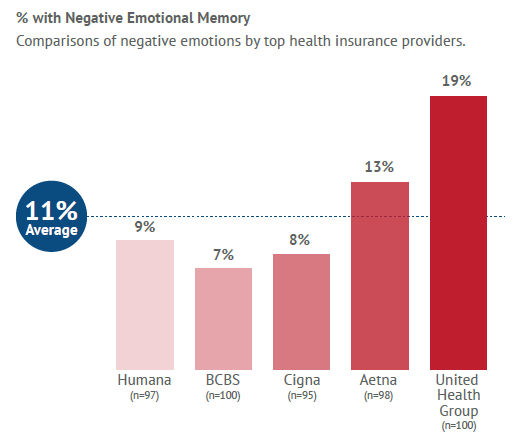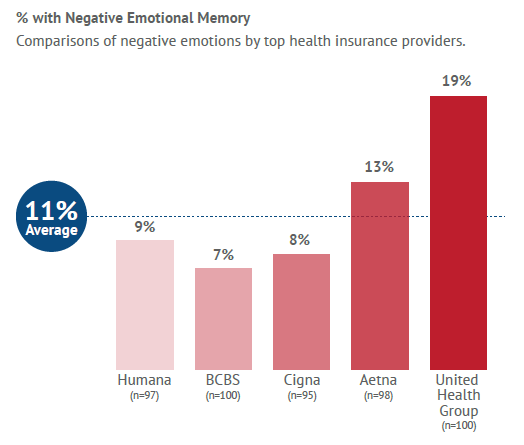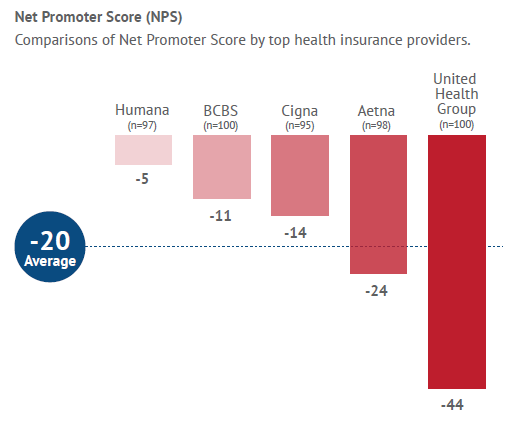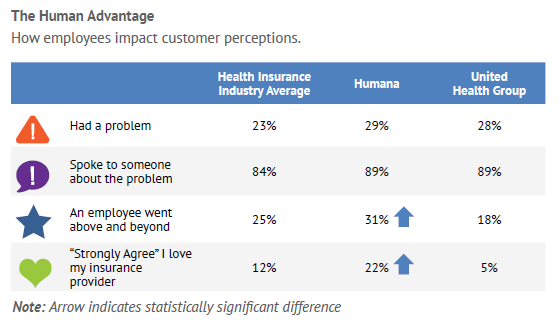The world of health insurance is on the cusp of a revolution. While many are still surviving, even thriving, on old models of doing business, the best are making preparations for the constitution of tomorrow. As consumers take on more of a decision-making role regarding the healthcare they receive, providers are forced to shift attention away from employers toward the end customer. This will fundamentally change the way that health insurers view customers, flinging them into the “Age of the Customer," an age where customers control the conversation and word-of-mouth can make, or break, a brand.
For our 2013 MECx study, we wanted to identify practical ways health insurance providers could begin to prepare for the new environment. We started by uncovering the drivers of strong Net Promoter Scores – that is to say the elements of the experience that either encourage, or discourage, a customer from recommending a brand.
What we found is that the lower the NPS score, the more negative the emotional memory is of that brand. The two charts illustrate this well – with top-performers creating fewer negative emotional memories and bottom-performers creating substantially more.
Next we looked at the types of emotions customers associate with their health insurer – particularly when the memory is less than positive. We found three emotions were most common:
- Confused
- Angry
- Unimportant
A person’s health and the health of their loved one’s is deeply personal, a reality that immediately shapes how a customer feels about their provider. What we found, however, is the puzzle piece that can combat these negative emotions – trust. Trust is defined as “having the customers’ best interest in mind.”
To understand trust a little bit deeper, we looked closer at the data for the top-performing health insurer, Humana. We wanted to identify how the Humana customer experience differs from that of other providers when it comes to elements of trust. We know from our 2010 Most Engaged Customers study that trust is created through consistency – that is to say avoiding problems leads to higher levels of trust. In the health insurance world when a customer experiences a problem it is often coupled with much more important, and highly stressful, issues related to their or their families, health. What we found surprised us - Humana customers report experiencing problems at the same rate as the other brands in our study, even those that were performing at the bottom of the rankings on NPS.
In other words, Humana is not building customer trust by creating fewer problems – problems are, to a large extent, inherent to the industry. We then looked at the number of customers who spoke to someone about the problem thinking that perhaps Humana encourages greater dialogue and openness with its customers –thus identifying and fixing problems at a greater rate. But, again, Humana performs at a rate that’s not statistically different from the industry average or bottom performers. The real difference in the levels of trust, positive memories and NPS scores for Humana versus all others is in customer responses to the question: “Did an employee go above and beyond for you?” Humana customers report that an employee went out of their way for them at a rate six points higher than the industry average.
This is an indicator of how critical human interactions are in earning trust and demonstrating to a customer that the company really cares about them. It isn’t so much about eliminating problems, or encouraging more customers to share their issues, but about how the employees in your organization are empowered, trained and supported to make customers feel like their problem matters and they’ll do all they can to fix it.
Not only do positive human interactions breed trust – they also breed positive emotional connections, even “love.” Humana customers are more than four times as likely to agree that they love their provider compared to customers of the bottom-performing brand.
For health insurance providers preparing to compete in this new environment, the 2013 MECx study offers four recommendations:
1. Define the customer experience you want to deliver.
Your Guiding Principles will give direction to all levels of the company – from senior management to the front lines – on how to create an experience that builds trust.
2. Identify your moments of truth.
The health insurance customer experience comes with several critical moments – understanding formulary rules, submitting a claim, changing providers, etc. The best way to get started transforming the customer experience is to start with these key interactions. Focus on making these emotionally charged moments smooth and easy for your customers and you’ll be rewarded with greater levels of trust down the road.
3. Listen to customers.
Customer-centricity is not yet the norm in health insurance. Those that are building customer feedback into their processes now stand to gain an enormous competitive advantage in the future. Consider a Voice of the Customer software platform to help you collect and respond to customer feedback.
4. Listen to employees.
This research makes it clear that employees are critical to higher NPS. Using employee satisfaction surveys or similar methods, pull in their perspective on the customer experience and tap into their insights on how to improve it.
–Kate Feather
The health insurance portion of the MECx Study are available in The Next Frontier: How to Gain the Customer Experience Advantage in Health Insurance.
Topics: Employee Experience, Customer Experience








%20(1).png)